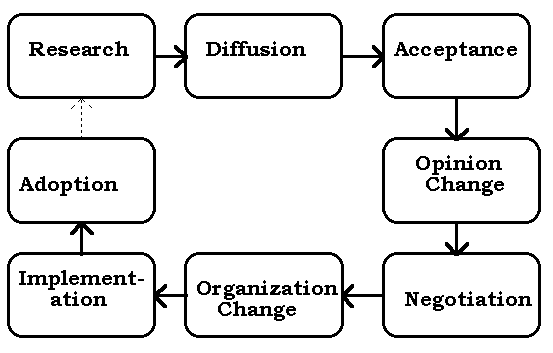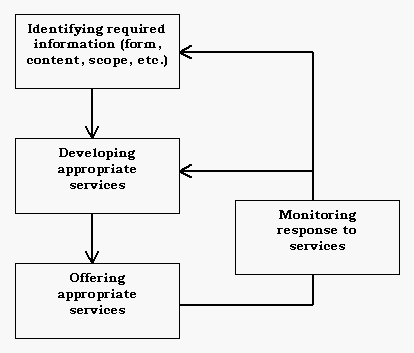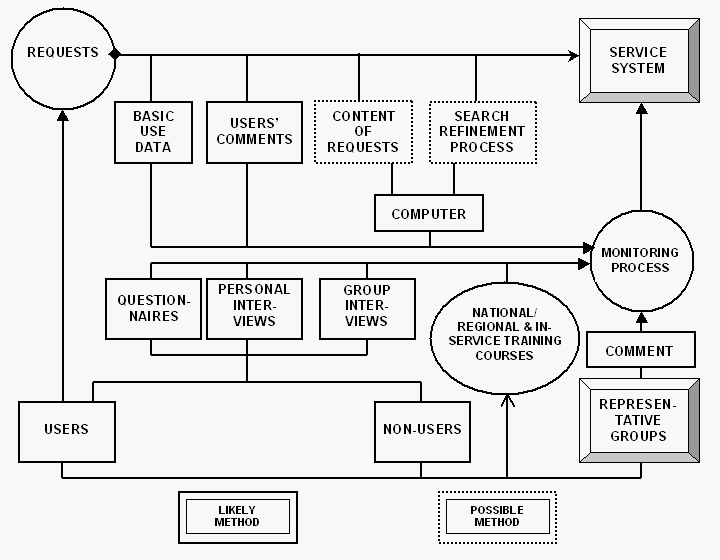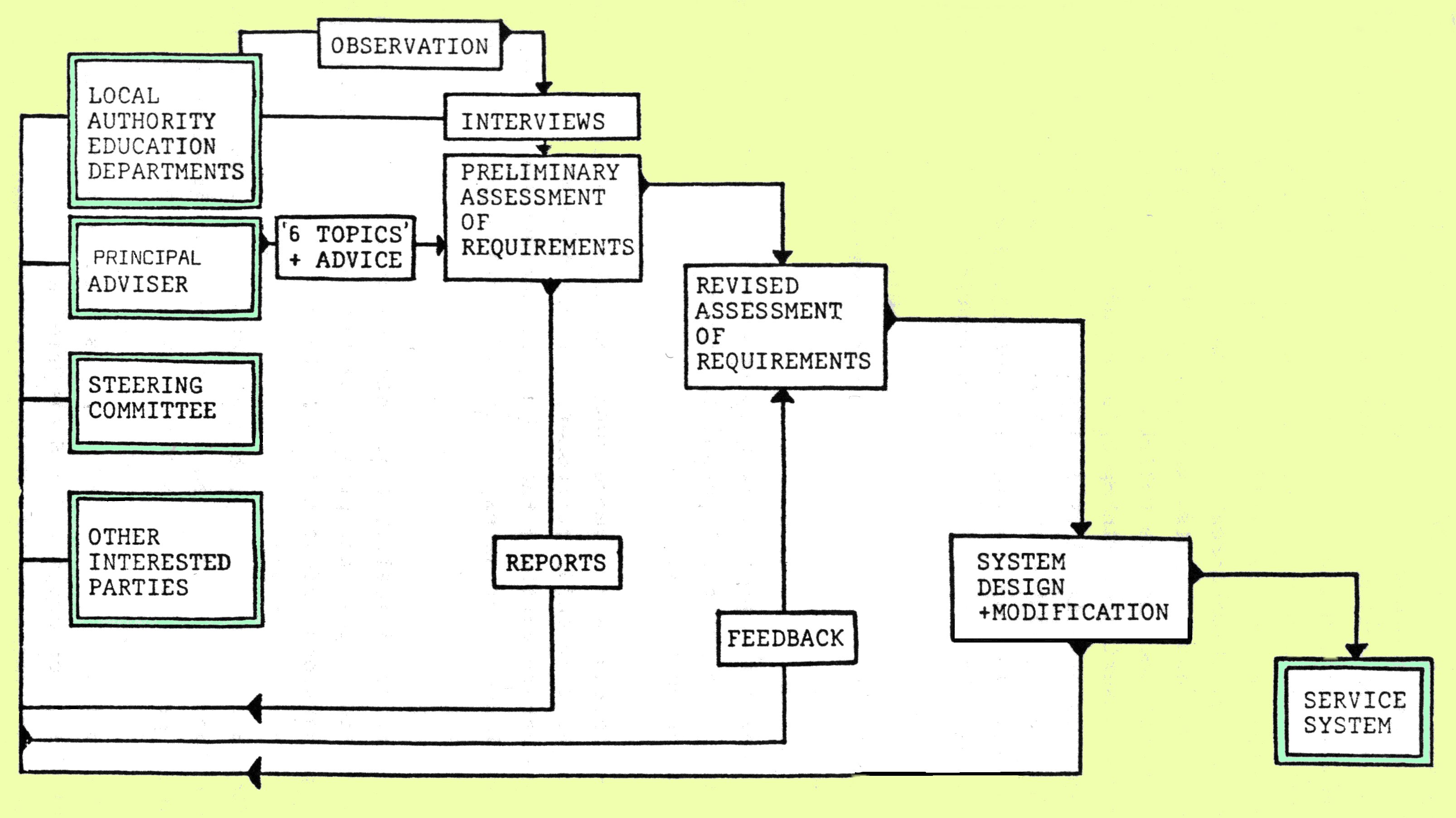Action research
and users' needs
T.D. Wilson and
D.R. Streatfield
Introduction
One of the recurring themes within information science is the application of research results to professional practice. In calling for research proposals, practitioners often seem to demand something which will show usable results quickly, since they perceive their problems as essentially practical. They sometimes find it difficult to grasp that if the research is intended to be fundamental it often cannot be carried out quickly and may not necessarily have practical results.
The difficulty that arises for the researcher is that, on the one hand, the practitioner wants applicable results, and, on the other hand, research funders generally want 'sound research'. At times the researcher is caught in the middle, trying to produce proposals to satisfy both. When research results fail to make any significant impact on the world of practice the response of funding agencies (not only in our field but in others too) is to stress the need for 'more effective dissemination'.
Dissemination of research
The proposition that dissemination of research results will increase the probability of application sounds reasonable. However, the process appears to be ill-defined and uncertain and the proposition can be doubted where the aims of research are basic rather than applied. It seems to us that there is confusion between the application of research results in science and their application in practice. We will explore this distinction further by reference to Figures 1 to 3.
In Figure 1 we have tried to illustrate the processes which are assumed to occur in disseminating research results using 'the scientific method model'. The key fact to bear in mind here is that, initially at least, the results of scientific research are applied in science itself rather than in any other field of practice. That is, results are used to support, confirm or deny the propositions of formal scientific theory. The use of science in technology or engineering may come rather later: witness, for example, the discovery of the properties of semiconductors in the 1920s and their application in the development of the transistor in 1948.
Figure 1 also suggests that, because scientific research finds its application within science, there will be a high probability that virtually continuous attention will be given to the same issues over long periods of time.

In information science, however, the research we are involved in is usually applied research: that is, it is related to problem-solving in the real world. (This is not to deny the possibility of a basic science of information but at present anything basic in our field appears to belong firmly within the bounds of some other discipline and information science takes on more and more the appearance of a multi-discipline). Almost always, too, our research is carried out in a real organizational world in which the application of research results necessarily involves some degree of organizational change.
If we assume that dissemination alone can bring about the necessary degree of organizational change then presumably we have in mind a process something like that outlined in Figure 2. The improbability of this actually happening on any large scale is so glaringly obvious that we have chosen to show it by using a broken line. The reason for the improbability is to be found in the box 'change in manager's view of organization': in other words, a change in attitudes is necessary, and social psychologists are fully aware that attitudes are deeply rooted and difficult to change. The force of a research finding would have to be so overwhelming that not only would the need for change be recognised but the will to change would be stimulated.

Action research - an alternative to dissemination
If we reject the notion that dissemination of results can work in this miracle way what is the alternative? One possibility which has been widely applied in many fields over recent years goes under the rather dramatic name of 'action research'. (Clark, 1972; Foster, 1972). Again, the process can be explained best by reference to Figure 3. This figure is rather more complex partly because the process is probably really more complex but also because it is rather better defined than the 'dissemination' model.

The fundamental differences between 'basic' research on the scientific method model and 'action research' can be seen clearly in this diagram. First, defining researchable problems is a collaborative process involving practitioners and researchers. Secondly, the research is problem-focussed (although the data may be relevant to basic research issues); and thirdly, the process has application and evaluation built in through the experimental innovation stage.
Generally, action research is presented as a form of organizational problem-solving in which the external researcher plays the role of consultant. (The field of organization development is one which uses this model, for example, French and Bell, 1973) . Clearly, however, this is not the only possibility and in the first project we shall describe, the process was what we shall call 'researcher-led'. By this we mean that the researchers were convinced that communication (and information) problems existed in the organizations concerned but that, in general, they would not be recognised as such by members of the organizations. This led the researchers to find settings in which to carry out action research and in doing so to demonstrate that their initial assumption about the existence of communication problems was correct.
This last point has a bearing on the difficulties likely to be faced by a researcher trying to negotiate entry to an organization to carry out action research. Some of the likely difficulties could be summarized as;
- the problem postulated by the researcher may not exist, or it may be the surface effect of more deeply-rooted problems. If this is not detected before the work commences, the researcher may be faced with issues and difficulties for which s/he is totally unprepared;
- a variation of this is that the problem may not be recognised as a problem by the relevant management staff;
- the researcher may believe that the source of the problem lies in the organization but management may think that it lies in the environment or in some controlling body;
- the concern of the researcher, in presenting his perception of organizational problems, may be in research as an academic activity: it may be difficult to negotiate, therefore, if s/he fails to realize that the manager may be more concerned with organizational survival and growth;
- acceptance of the researcher's ideas may be a management ploy, a move in a personal power-game, etc., rather than a genuine recognition that the problems outlined are real;
- key individuals may seek to direct the research towards the justification of decisions already taken. (Based upon Foster, 1972).
Action research and Project INISS
Project INISS was planned as an action research project from the beginning and three stages were envisaged:
- a period of data-collection through structured observation in social services departments, which would give the researchers insights into the day-to-day functioning of the organization, as well as allowing the development of research hypotheses (see Wilson and Streatfield, 1977);
- a stage of structured interviews to allow for the collection of a greater amount of data to test research hypotheses (see Wilson, Streatfield, and Mullings, 1979);
- a period of experimental implementation of innovations in information services following upon the feedback of data from stages one and two. The choice of innovations would be made in consultation with departmental management and field staff (see Wilson and Streatfield, 1982).
In spite of a short gap in the duration of the project, which was the result in a change in funding organization after the interviewing phase (from British Library Research and Development to Department of Health and Social Security), the three phases detailed above were followed and the process followed the model in Figure 3, allowing for the fact that the whole project was 'research-led'.
It should be noted that the 'innovations' which were implemented were in no sense 'novel' to information workers: the novelty lay in the fact that virtually any information service was a novelty in the kinds of organizations in which the work was done. Initially, the funding agency (DHSS) was presented with a menu of almost thirty ideas for improving communication and information flow at all organizational levels. We were advised to focus our efforts upon the fieldwork level (that is, the level at which service is given to clients), and, as a result, the list was reduced to eight innovations. Following discussions with a number of departments (some of which had participated in the work from the beginning of the project) these innovations were eventually applied in a total of eighteen locations (area offices) in seven social services departments in three types of local authority: Shire County, Metropolitan District, and London Borough.
The innovations were:
- in-service training courses in communication and information handling (see Streatfield, Clark, and Hill, 1980);
- the development of local information collections relying upon organizational information and material from voluntary agencies, designed to be low-cost, easily- maintained collections;
- collections of monograph literature, supplied to area offices either by the local county library service or the department's own research library service (see Streatfield and Pritchard, 1981); an index to expertise;
- more effective journal provision;
- an abstract bulletin service (see Streatfield and Pritchard, 1981.).
- assistance with the evaluation of a staff information bulletin; and
- the provision of background papers for in-service training courses.
Clearly, there is rather more work involved here than can be presented in detail in a paper such as this and we will concentrate on our general conclusions as they related to the usefulness of the action research mode. Anyone wishing to have more detailed information on any particular innovation is invited to contact the authors.
Conclusions from the innovation phase of Project INISS
The conclusions of the innovation phase can be set out as follows:
1. Genuine collaboration with those directly affected by the innovation is absolutely essential. In one particular application it was clear that the area officer developed an 'instant enthusiasm' for organising information collections which was not recognised as a passing phase by the higher management or the researchers. Consequently, when her initial commitment to the idea fell away this was reflected in the attitudes of other members of the area staff who were used to these sudden bursts of enthusiasm. This innovation was markedly less successful in this office than it was in another department.
2. Genuine collaboration in defining the research problem is also important even with a 'researcher-led' programme. For example, the research team had originally intended to explore methods of providing information support for problem-solving groups such as internal working parties. This idea was transformed at the initiative of the host department (with the full agreement of the researchers) into broader support for in-service training courses).
3. Support from the local area management is essential. Again, in another test of the information collection innovation, the local area director was very enthusiastic (he had been one of our original observation subjects). He provided space, organized part-time manpower support and generally encouraged his staff to make use of the collection. In other innovations, also, where senior management were responsive to our ideas and where they believed benefits would flow to the organization, the task of introducing an innovation was made much easier.
4. A user group which is apparently difficult to motivate to use information (social workers) will respond to the provision of information services at the workplace. Both the book collections and the information collections were used (in different ways, and with different degrees of intensity) in departments where long-distance use of central facilities had been virtually zero.
5. To be useful the information provided must relate to the current problems or issues of interest to the recipient.
6. It is possible to bring about sufficient organization change through action research to enable innovations to be adopted (or for other innovations to be adopted on the basis of lessons learned), after the experimental period. This can be achieved if the innovations are effectively monitored and evaluated and are seen by organizational staff and management to address problems of significance to the organization. Perhaps the most telling illustration of this was given to the authors after the conclusion of the project. A research officer reported that the abstract bulletin innovation had been virtually the only information service to survive drastic cuts in his budget. In fact, the service was now being provided to all area offices in the authority and the resources available were being used to buy more subscriptions to the bulletin (Social Work Information Bulletin) rather than to buy books or new journal subscriptions.
7. One of the most effective ways in which to bring about an awareness of communication and information problems and a readiness to accept innovation is through training. In two authorities we organized training courses, in association with the departments ' training sections. These have been described elsewhere (Streatfield, Wilson, and Clark, 1981) , but the conclusions from the evaluation are worth repeating:
During follow-up interviews it became clear that course participants were:
1. attempting to be more systematic in their preparation for and conduct of meetings;
2 more aware of the need to be conscientious in passing on information to their subordinates;
3 more aware of the information requirements of colleagues;
attempting to control their own information more effectively (e.g. by re-organizing and weeding filing systems);
4 active in promoting more effective information handling and use (e.g. by setting up team libraries, or reproducing and distributing course hand-outs); and
5 were aware of changes in other people's information related behaviour which could be attributed to the course.
A second project: the Educational Management Information Exchange (EMIE)
The second project described here came about in a different way and the role of the external researchers is likely to change between that of consultant, as usually envisaged in action research, and direct initiator of services. An element of speculation is inevitable in this case because this project has run only nine months of a four year programme and the final results of the continuing collaboration with participants cannot be anticipated.
In this example, the initiative to set up the Education Management Information Exchange (EMIE) as an experimental service came from the likely participants. This came through the Society of Education Officers which is the professional body for senior administrators in local government education departments in England and Wales. Joint sponsorship for the research project in which EMIE is based is being provided by the Society, by the central government Department of Education and Science and by the National Foundation for Educational Research.
You will not be surprised to learn that we aren't yet ready to set out conclusions about this project! Instead we will show in Figures 4 to 6 how we anticipate that the project will operate.

Figure 4 shows the various phases in our project programme. You will notice that we view the whole process as a continuous one throughout the life of the project. This diagram is pretty meaningless without some indication of what the monitoring phase is likely to involve and this we have shown in Figure 5.

We suspect that the only service monitoring carried out by many information services is to record the number of requests received or items provided on loan. One might add the monitoring of user's comments but how many services record these systematically? The fact that the documentation part of our service will be supported by the IBM Stairs computer package holds out the possibility of our analysing the content of requests and looking at patterns in refining the search process for individual enquiries.
Turning our attention to potential service users I think it is worth stressing that we envisage the service as an information exchange. Not all the services offered are likely to work through our service centre and whatever services we do offer can only work if we ensure maximum participation by our users. For this reason we will be seeking practitioners' reactions to the problems encountered, desirable services and practical possibilities.
We will do this through individual or group interviews and possibly through questionnaires. (For guidance in exploring these issues see Mullings, Francis, and Wilson, 1981). More significantly, we will seek active collaboration from practitioners by establishing a series of link-people in each local authority and we will involve practitioners in training courses looking at information in an organisational context.
We envisage this activity as a very important part of the overall process because training courses of the kind we will offer should:
- enable practitioners to focus their attention on communication issues which they might otherwise take for granted;
- enable the project team to come into closer contact with the practical issues facing practitioners in their day-to-day work;
- encourage a much more equal exchange of problems and ideas between practitioners, information specialists and their advisers than could be achieved by an 'information officer as expert on information provision' approach;
- more specifically, this interchange should provide a chance to tell the project participants where they are going wrong and give them a chance to put it right.
At an informal level the project staff are already making heavy use of the Society of Education Officers as a point of access to education practitioners.
It will be obvious that much of what has been expounded in this account is based on Project INISS experience. This is even more true of the preliminary stage of the project which was concerned with finding appropriate areas of work for the information exchange service. Figure 6 shows the steps which we have already worked through in setting up the service. One weakness in the project programme is that the amount of observation and interviewing we are able to carry out is not large enough to ensure equal partnership between the researchers and practitioners at the next stage of involvement. The 'outsiders picture' of their work which the researchers presented to practitioners was a strong stimulus towards change in the social services project. In the current project the kind of picture which we can offer will be tentative. Fortunately, we will also be able to offer a comparative picture from the social services project and as the approach gains wider acceptance the results of comparative studies will increasingly become available to illuminate later work.

The next step will be to spend six months with link people and other staff from 30 of the 104 education authorities in England and Wales to test out some of our (and their) preliminary ideas for specific services. We are aiming to open the full scale service next March and are looking forward to finding out what we will be doing then.
Conclusions
We have discussed some issues in applying action research methods to information science and looked at two examples. We will conclude with some general comments about the implications of this approach for information science generally and information service provision in particular.
In our view the 'university library model' of library service works well when the users are highly motivated to seek out the literature and when the literature is readily accessible. Similarly, the 'scientific research organisation' model of information service is appropriate when the users can readily define their subject interests and are interested in everything published on their specialisms and when bibliographical control of the literature is comprehensive, particularly if there is also a strong incentive to publish the results of research.
The proposition underlying our work and the one which led us to adopt an action research approach is that these two 'service- based' models of information provision work much less well when applied to other user groups, such as local government practitioners.
A cautionary note should be sounded here. The action research process is heavily dependant upon adequate evaluation by the participants in all the phases of the action, including evaluation of the evaluation process itself. This aspect of action research has so far received less attention than it merits. (Incidentally, we have published two papers on our own evaluation programme: Pritchard, Streatfield, and Wilson, 1979; Streatfield, Pritchard and Wilson, 1981).
An action research approach to information service development may be difficult to 'sell' to sponsors because it is possible to go ahead and apply variations on the two models just outlined and be seen to be busy doing something, however peripheral to the main communication problems of the organization. However, an action research approach offers a number of advantages:
- it enables the information specialists to learn more about the real communication problems of potential service users;
- the problems will be seen in their organizational context;
- it should be possible to learn more about how practitioners do their work and about their perceptions of the part which information plays in that work;
- it provides a means for the information specialist's knowledge about information services and techniques to be explored from the point of view of their relevance to the problems in hand;
- it helps to raise awareness of the problems surrounding the communication of information both for practitioners and information specialists;
- it helps generate the conditions in which organizational change can be achieved.
In short, action research provides the means to redefine the relationship between the information specialist and the potential information user.
References
- Clark, P.A. (1972) Action Research and Organizational Change. London: Harper and Row.
- Foster, M. (1972) An introduction to the theory and practice of action research in work organizations. Human Relations, 25, 529-556.
- French, W.L. and Bell, C.H. (1973) Organization development: behavioral science interventions for organization improvement. Englewood Cliffs, N.J.: Prentice Hall.
- Mullings, C., Francis, G.M., and Wilson, T.D. (1981) A manual for the investigation of local government information needs. Sheffield: University of Sheffield, Postgraduate School of Librarianship and Information Science. (British Library R+D Dept. Report 5585).
- Pritchard, J., Streatfield, D.R., and Wilson, T.D. (1979) An illuminative programme for assessing information services. Aslib Proceedings, 31, 245-50.
- Streatfield, D.R. and Pritchard, J. (1981) Putting information on tap: if it is true that social workers stop reading about their profession as soon as they qualify, it may be the fault of the information systems. Social Work Today, No. 1249, (August 25) 8-10
- Streatfield, D.R., Clark, D., and Hill, H. (1980). Training social services staff to make better use of information: an account of two practitioner-training courses and their implications, Aslib Proceedings, 32, 134-44.
- Streatfield, D.R., Pritchard, J., and Wilson, T.D. (1981) Assessment of an illuminative evaluation programme for information services. Aslib Proceedings, 33, 67-70.
- Streatfield, D.R., Wilson, T.D., and Clark, D. (1981) A problem-based training approach to information for practitioners. Libri, 31 (3), 243-257
- Wilson, T.D. and Streatfield, D.R. (1977) Information needs in local authority social services departments: an interim report on Project INISS. Journal of Documentation, 33, 277-93.
- Wilson, T.D., Streatfield, D.R., and Mullings, C. (1979) Information needs in local authority social services departments : a second report on Project INISS, Journal of Documentation, 35, 120-36.
- Wilson, T.D., and Streatfield, D.R. (1982) Information innovations in social services departments: a third report on Protect INISS. Journal of Documentation, 38, 273-281
Notes
1. These initials stood for two titles over the life of the project; 'information needs and information services in local authority social services departments' and 'information innovations in social services'.
2. t.d.wilson@shef.ac.uk and streatfield@compuserve.com